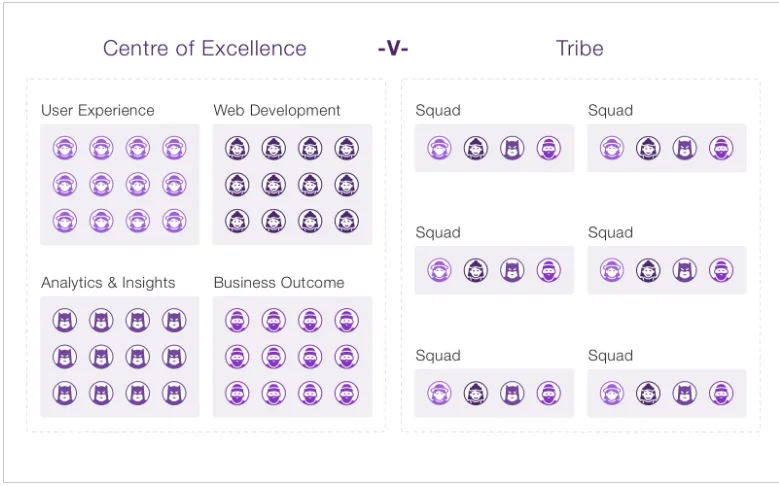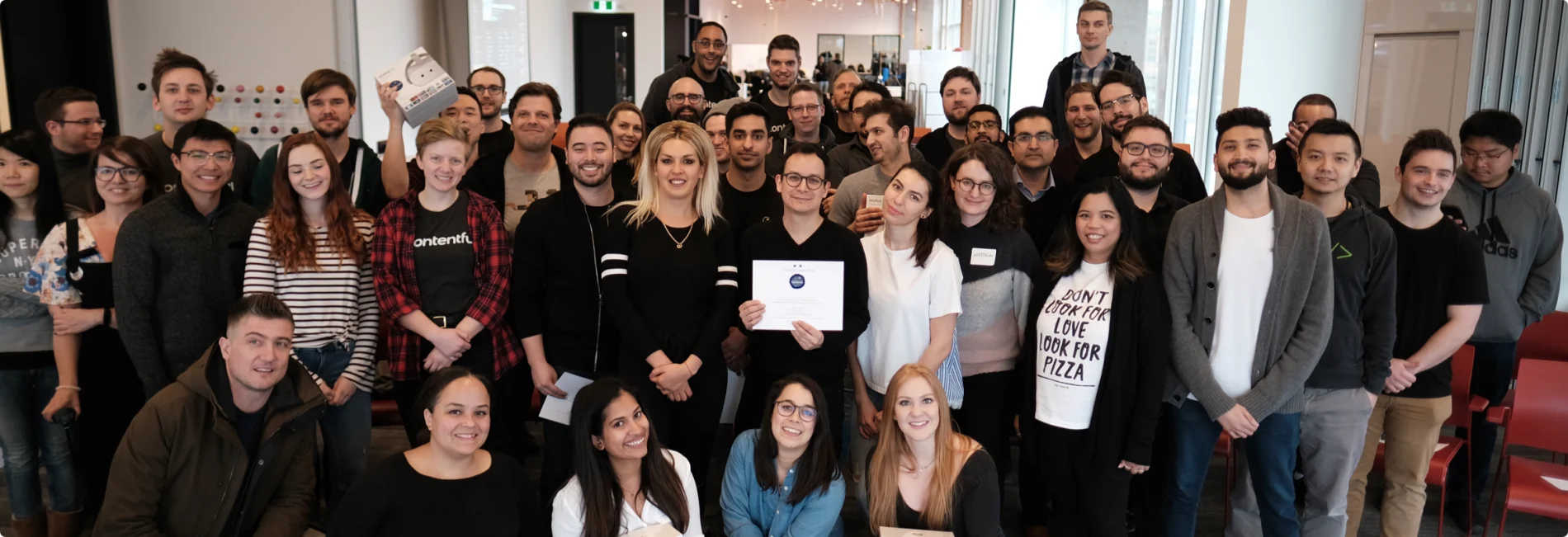6 powerful ways to grow communities of practice within an enterprise
Culture · Jan 29, 2019
According to the SAP Digital Transformation Executive Study, 80% of companies that have embraced digital transformation have experienced increased profitability when compared to other companies. So why is it that only 21% of companies have completed their digital transformation?
Digital transformation is difficult - and scaling this transformation alongside creating an engaging digital culture might be one of the most difficult issues companies face.
7 years ago, TELUS rose to this challenge by starting an incubator within their large organization and called it TELUS Digital. What started off as an experiment has now grown to 425 person operation passionate about driving digital evolution within a large telco. With 300 releases per day (28,000 per year) we’ve enabled our team members to build the best experiences for our 13+ million customers, at a speed that gives us the best chance possible of being first to market.
But as TELUS Digital continues to scale, it is crucial that our team creates an engaging digital culture to accelerate digital transformation to the rest of the organization. One of the most successful solutions in fostering an engaging digital culture is our communities of practice.
A community of practice is a system of guilds, online communities, collaboration tools and professional development initiatives that are designed to coordinate the advancement of digital skills throughout TELUS. In combination with the Digital Platform, our communities of practice enable diverse teams to be stood up at a moment’s notice, providing us with the agility to overcome new challenges as they arise. As a result, our communities of practices have saved us around 135,000 hours through effective collaboration and as an engine driving teams to reuse content objects, code and design.
Evolutionary leaps to communities of practice
Communities of practice haven’t always been around at TELUS Digital. They arose from the need to provide better mentorship, skills and professional development to team members. Early on, one of the steps in transforming our digital culture meant moving from a more traditional model of disciplined-focused teams (dubbed “centres of excellence”) to the scaling agile model of tribes and squads (inspired by the “Spotify framework”).

Unlike centres of excellence which had pockets of skill-based individuals, the scaling agile model would mean that we were able to distribute expert skills throughout different teams. One of the immediate benefits of this meant that individuals from different disciplines (e.g.: design, product, content, development, etc) could work alongside each other to share a collective responsibility and sense of ownership around business outcomes and objectives.
There was a clear need for us to create a solution to address the growing pains of undergoing digital transformation.
However, our team faced some challenges with this model. Individuals felt a sense of isolation from their peers as there was an unclear path for professional growth or mentorship. It also became hard for disciplines to maintain and communicate the evolution of best practices and standards across teams. There was a clear need for us to create a solution to address the growing pains of undergoing digital transformation. Thus, we began the second evolution of our digital culture: implementing communities of practice.
How to enable and empower your communities of practice
With much trial and error, our team has been able to curate the most successful solutions that make up our communities of practice and contribute to our thriving digital culture. Through these solutions, we are able to nurture a positive ecosystem between professional development and delivery within a large organization.
1. Bring people together through chapters of experts
A core component to the communities of practice is setting up chapters of experts to share knowledge. In essence, you’re bringing together a group of individuals who share the same set of skills, within a common location. This becomes important for an enterprise like TELUS where there are multiples offices, and some team members completely remote. For example, both our Toronto and Vancouver design chapters consist of designers, developers and UX experts, led by a practice lead (a senior expert).
2. Enable curiosity and problem solving through guilds
Through guilds, these experts develop a cadence to meet and collaborate on challenges, share best practices or dedicate the time to learn (from peers or speakers). It is important to note that guilds are open meetings that anyone can join if they’re curious about that area. By using tools like Google Meet and Meetups, this invitation can be extended to team members across TELUS, as well as vendors and partners working with us. This allows for greater collaboration and problem solving across multiple chapters and even tribes, as different experts can attend guilds to offer new perspectives rather than teams working in silos.

For example, in a design guild an SEO or accessibility expert might be interested in attending to offer their perspective on descriptive text. The structure of the guilds also allows for individuals with a passion or interest in a particular area the ability to still be part of the conversation or potentially raise their hand to make a career switch into that practice.
3. Allow leads to set skills and communicate best practices
The role of a lead becomes extremely important in these chapters and guilds as they are tasked with both facilitating professional development for individuals as well as communicating best practices to the rest of the enterprise. A lead would need to set expectations on the level of skill required by different types of practitioners, foster growth and provide mentorship between the different levels. For example, our content practice has three types of roles: UX copywriter, content manager and content strategist. While each role may require unique skills (e.g.: CMS experience for a manager), there is still a baseline of similarities that every individual within this chapter must have and which a lead would have to set. A lead would also need to establish and communicate the standards that every expert should adhere to (e.g.: tone of voice). Leads will often leverage guilds to communicate these standards and facilitate knowledge sharing to the rest of the organization since the open structure of the guilds allows for a wider audience.
4. Dedicate space and time for professional growth
Once our team set up chapters of experts and guilds, we had to develop a solution to streamline these meetings while empowering team members to attend guilds they were interested in. We also needed to create a forum to share general updates, key wins and lessons learned that were applicable to every TELUS team member, vendor and partner. We decided to create “Meeting Mondays”- a dedicated day for professional development and communicating change.
Meeting Mondays is the idea that all of our meetings, guilds and forums are hosted on Monday so that team members have the rest of the week dedicated to their work or maker-time. Here is what a typical Monday may look like:

In 2018, we’ve had approximately 70-100 sessions per month conducted by team members. By creating a space dedicated to professional development via guilds and communicating enterprise-wide change through forums and meetings, we’re able to accelerate our digital transformation.
5. Assign ambassadors to solve platform challenges
Our Digital Platform is an ecosystem of tools, technologies and practices that allow us to deliver world-class customer experiences quickly through reusable components. However, a problem that quickly surfaced was that each squad wanted to create unique components to solve their individual problems. Our team needed to knock down the silos by encouraging and cultivating a culture of sharing and community to allow multiple squads to identify reusable patterns in their workflows and collectively arrive at one solution that provides the best possible customer experience.
To do so, we created a council of 20 ambassadors; individuals who were chosen to represent each outcomes team (Mobility, Home Solutions, Business and My TELUS) and platform team (TELUS Design System, content platform, etc). Squads could work with these ambassadors to surface issues and the ambassadors would bring them back to the council. Once a week (on Meeting Mondays), all ambassadors would meet to share problems, prioritize issues, vote on which components needed to be built quickly and suggest requirements for improving contributions. As a result, these ambassadors could tackle issues at a squad level, across all outcome teams and collectively work with other ambassadors to share and accelerate solutions.
6. Build relationships online and offline
Taking your communities of practice to the next level means flourishing relationships outside of guilds and dedicated meeting days. Slack is an awesome tool to help to keep the momentum of important conversations going throughout the week. For instance, chapters will come together to set up their own channels where experts across the organization can pop in to ask for help, find information or share interesting trends from the industry. By fostering an online culture, individuals are able to feel a sense of belonging and community, regardless of where they are located (e.g. team members working remotely or in a different part of the country).
Face-to-face conversations are just as fruitful. We encourage all of our leads and senior leadership to be accessible and transparent, whether that means facilitating regular 1:1s with team members or casually going for coffee (or danishes). In 2018 for example, 1,400 connections were made through the Donut bot integration through our Slack. By creating an environment where team members feel that their leadership is approachable, they feel empowered to ask hard questions, raise important issues or explore their potential at TELUS.
What’s next?
At TELUS Digital we understand that digital transformation and digital culture are inseparable in order to survive in a competitive digital landscape. As we continue to scale, we hope to continue to grow our thriving digital culture through our communities of practice - whether that means investing in the right tools or empowering the right people to make it happen.
In the upcoming weeks, we’ve pledged to give back to the greater digital community outside of TELUS by releasing playbooks on how we execute these solutions, step by step. Make sure to follow us on LinkedIn or Twitter so you don’t miss out!



